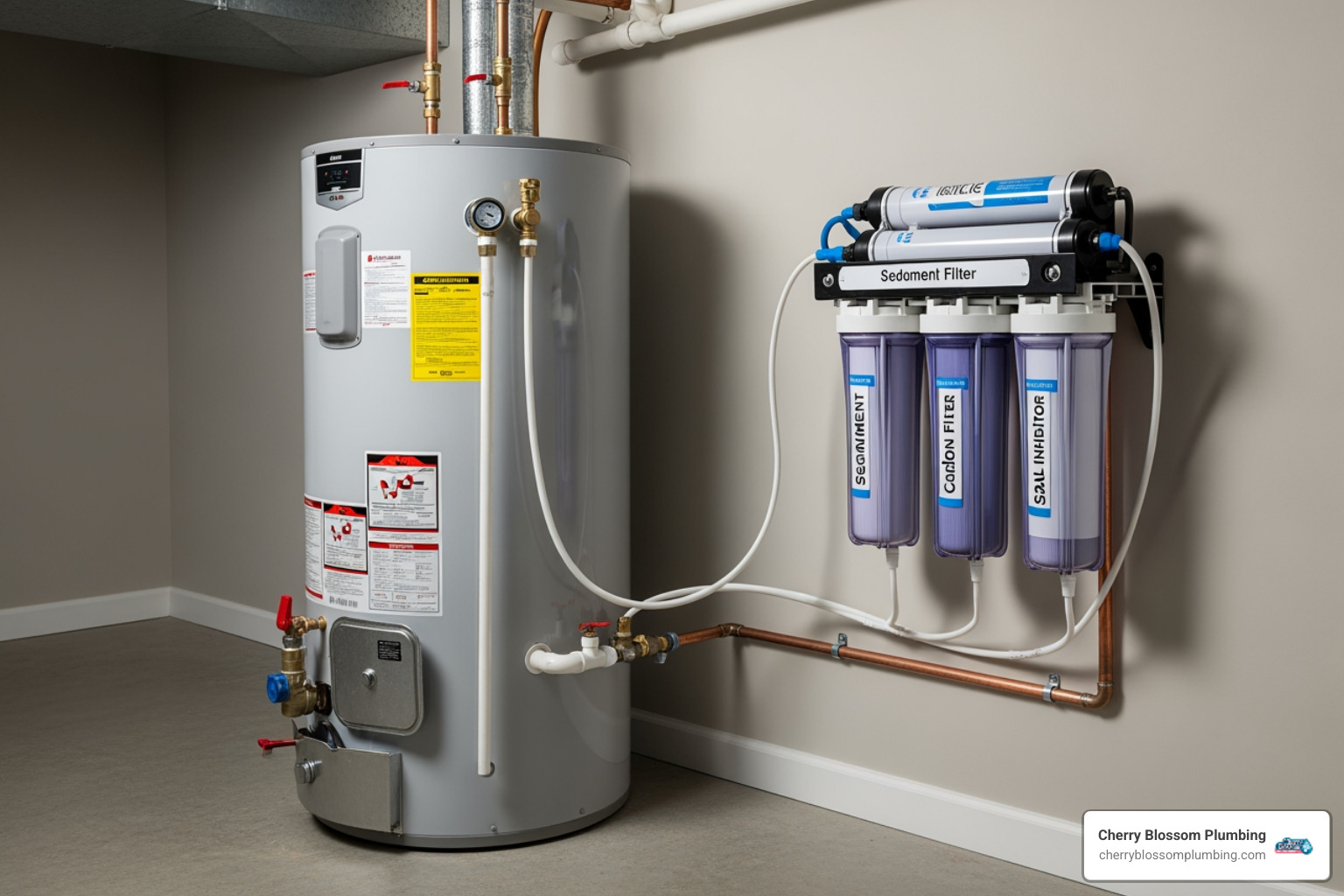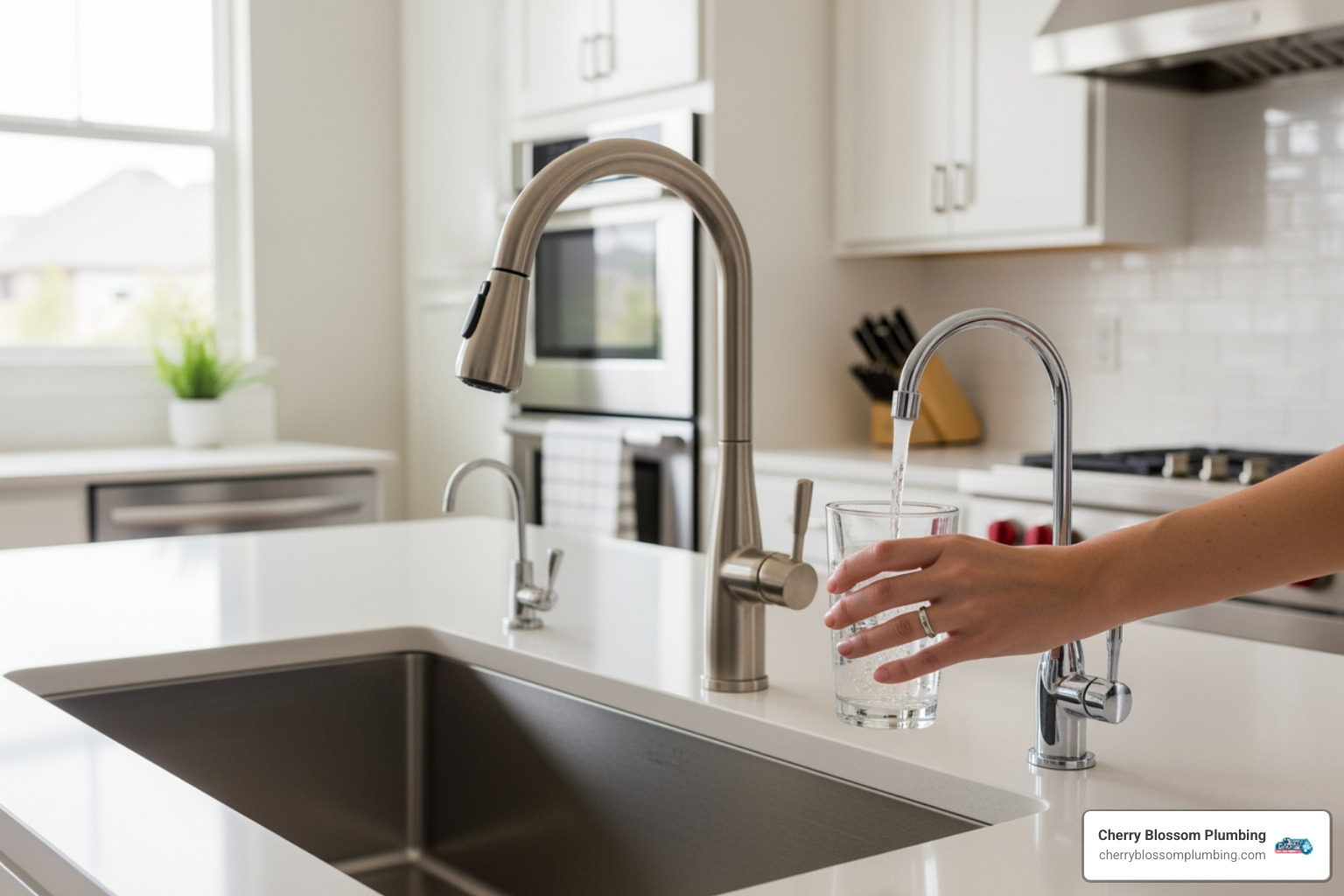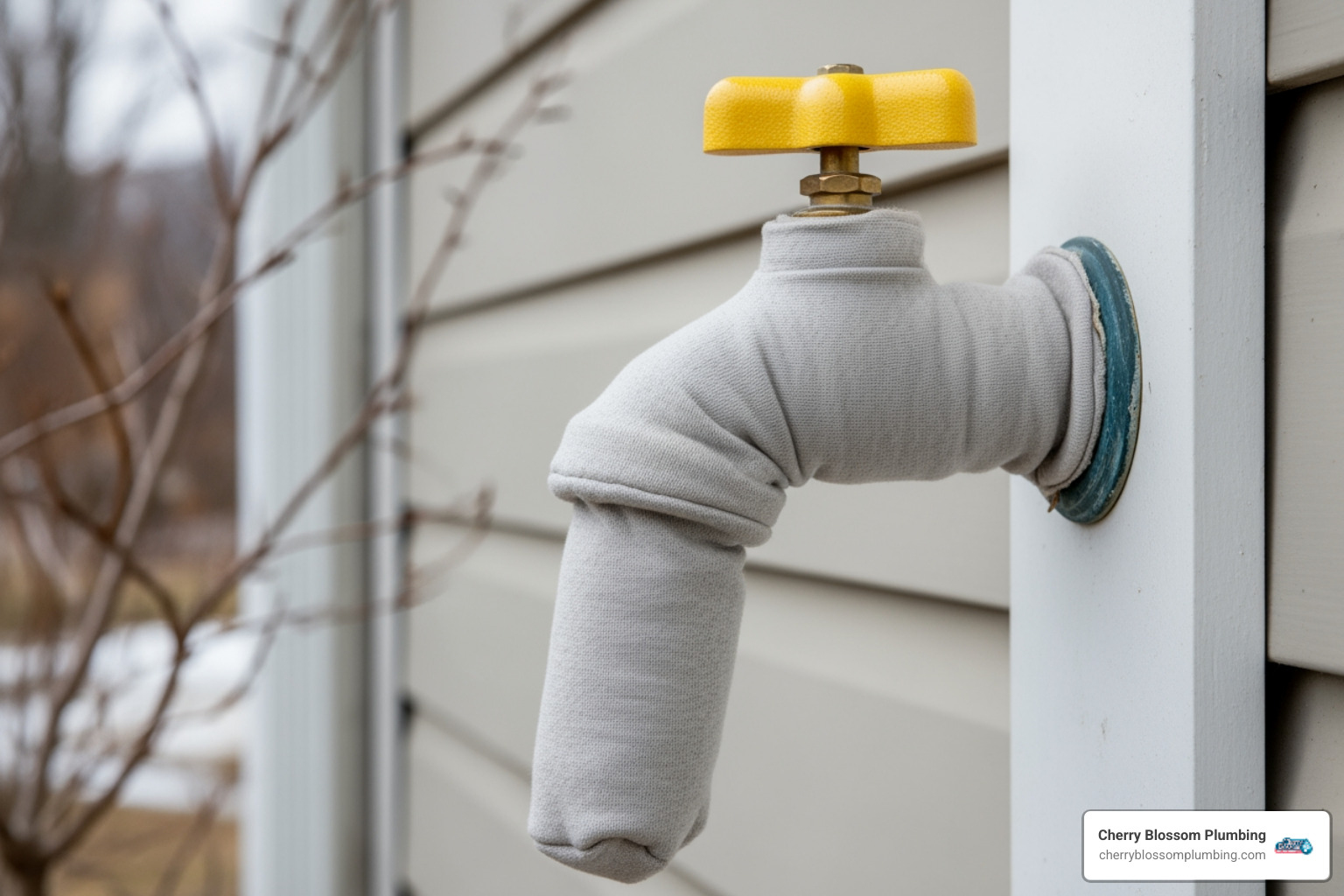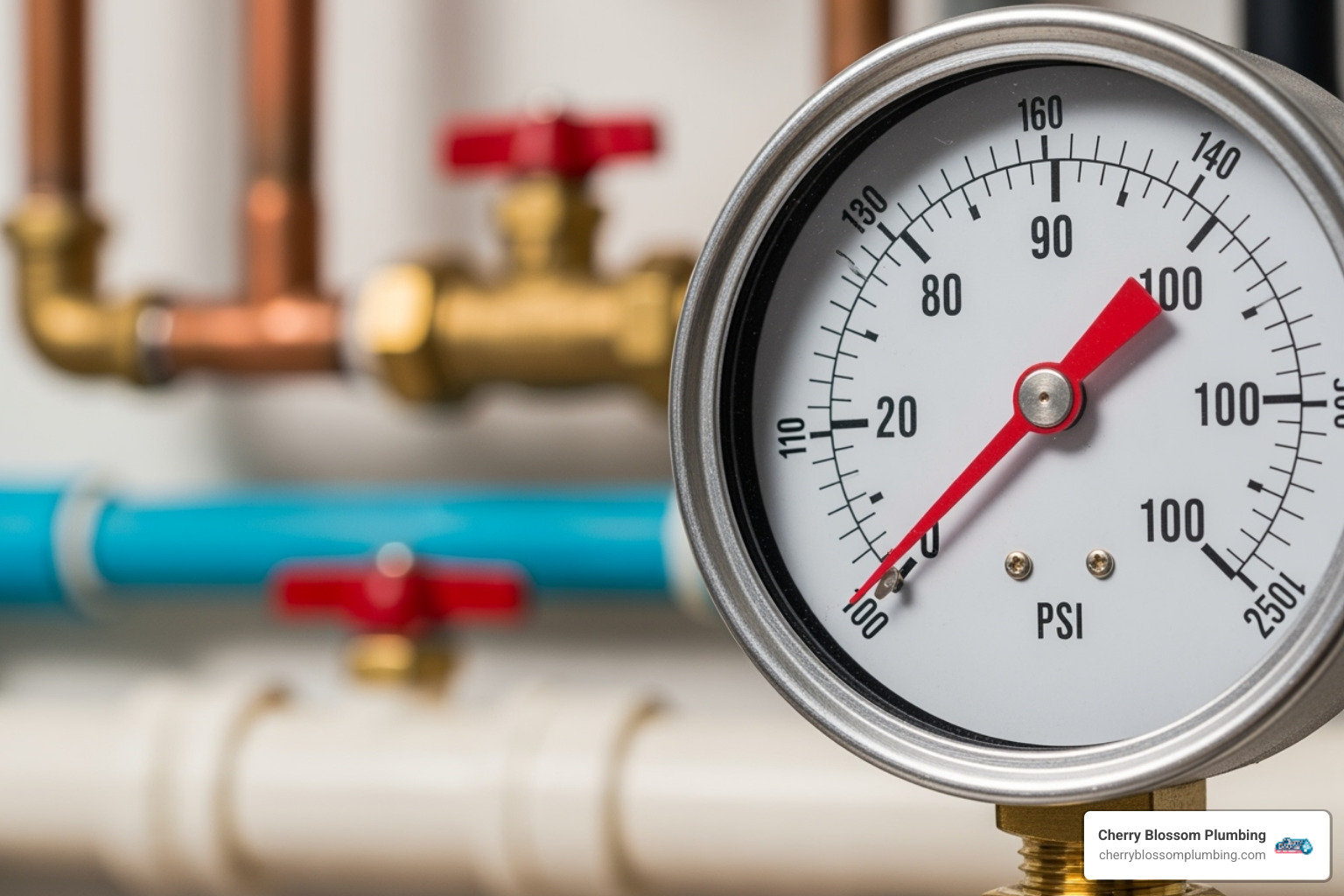
Why High Water Pressure is a Hidden Threat to Your Home
High water pressure might feel amazing in the shower, but it can silently damage your home's plumbing system and cost you thousands in repairs. While most homeowners worry about low water pressure, excessive pressure above 80 PSI puts dangerous strain on pipes, appliances, and fixtures throughout your home.
What You Need to Know About High Water Pressure:
- Normal Range: 40-80 PSI (pounds per square inch)
- Ideal Range: 40-60 PSI for optimal plumbing health
- Danger Zone: Above 80 PSI can cause serious damage
- Common Signs: Banging pipes, leaking faucets, running toilets, noisy appliances
- Hidden Costs: Premature appliance failure, voided warranties, higher water bills
You probably know that low water pressure is frustrating - nobody wants to spend forever washing shampoo out of their hair. But high water pressure can be an even bigger problem, causing pinhole leaks in pipes, broken seals, and appliance breakdowns that happen behind the scenes until major damage occurs.
The good news? High water pressure is completely manageable once you know what to look for and understand your options.
I'm Amanda Casteel, and through my work with Cherry Blossom Plumbing, I've helped countless Northern Virginia homeowners identify and resolve high water pressure issues before they cause expensive damage. My background in systems management helps me break down complex plumbing problems into simple, actionable solutions that protect your home and your wallet.
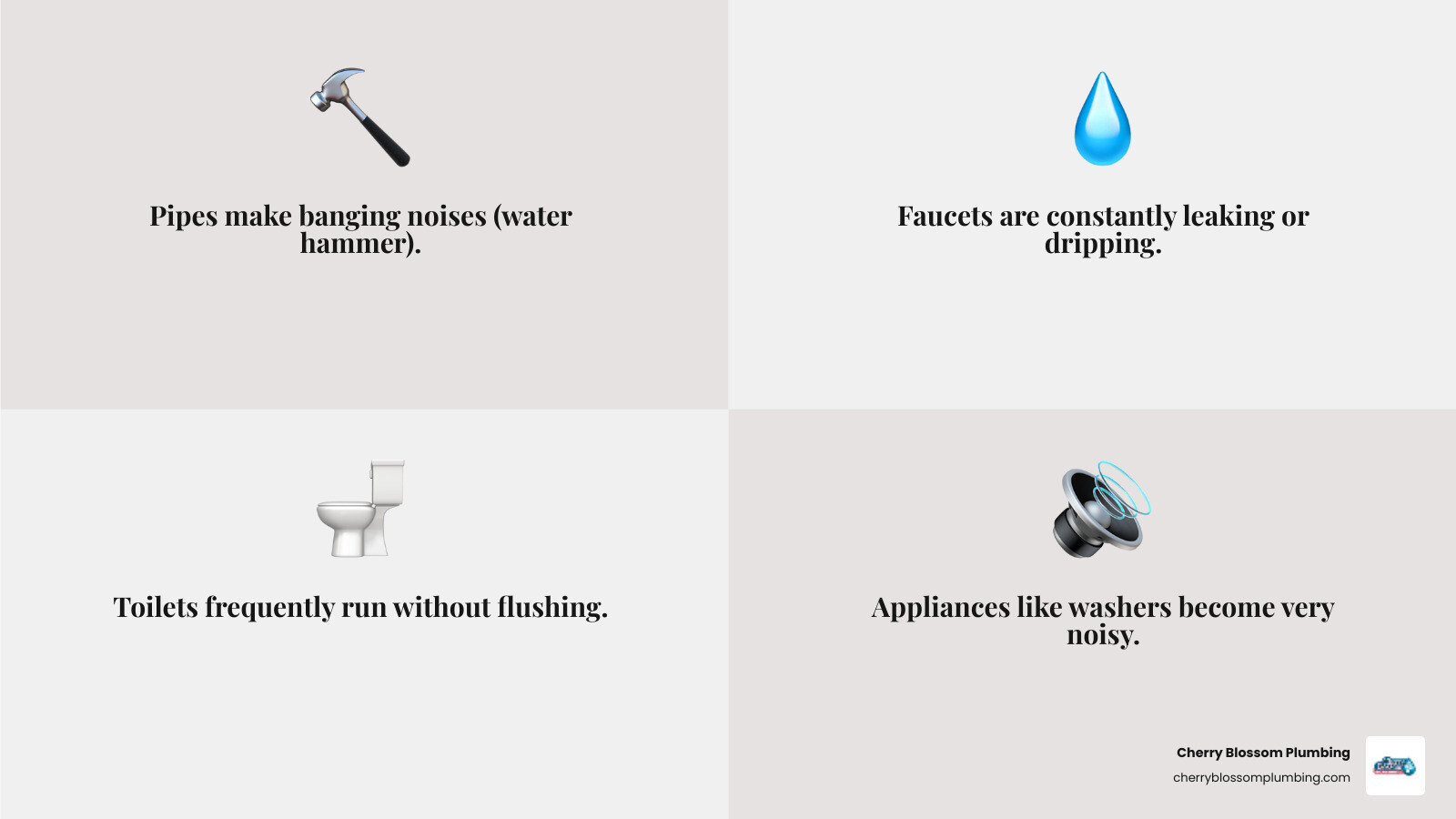
What is High Water Pressure and How Do You Spot It?
Water pressure is simply the force that pushes water through your home's pipes, measured in pounds per square inch (PSI). Think of it like the strength behind the water flow - too little and you get a disappointing trickle, too much and it can literally tear your plumbing apart.
Most homes are designed to handle water pressure between 40 and 80 PSI, but here's what many homeowners don't realize: just because your system can handle 80 PSI doesn't mean it should. The sweet spot for protecting your plumbing and appliances is actually 40 to 60 PSI.
Once you consistently hit above 80 PSI, you're in the danger zone where high water pressure starts causing real problems. Building codes in Arlington and Falls Church recognize this - they require pressure to stay under 80 PSI for good reason.
Here's the tricky part: our municipal water systems need to serve entire neighborhoods, often using gravity from liftd water tanks or powerful pumps. While this engineering marvel ensures everyone gets water, it can mean some homes end up with pressure that's higher than ideal. This is especially common here in Northern Virginia, where our hilly terrain and varied infrastructure create a patchwork of different pressure zones.
Common Signs of High Water Pressure
Your home is constantly giving you clues about high water pressure - you just need to know what to listen for. Water hammer is probably the most dramatic sign: those loud banging or clanging sounds when you turn off a faucet. It happens when high-pressure water suddenly stops and creates shockwaves that slam through your pipes like a freight train.
Leaking faucets that keep dripping even after you've replaced all the washers are another telltale sign. High water pressure overwhelms the seals and components in your fixtures - imagine trying to hold back a firehose with your thumb, and you'll get the idea.
If your toilets are constantly running or refilling on their own, excessive pressure might be wearing out those delicate internal mechanisms. The same goes for noisy appliances - when your washing machine or dishwasher sounds like they're working overtime, it's often because high water pressure is forcing them to work harder than they're designed to.
Premature appliance failure is perhaps the most expensive symptom. We regularly see water heaters, washing machines, and dishwashers failing years before they should, all because constant high pressure accelerates wear and tear on pumps, seals, and other components.
Here's one that surprises people: low hot water supply. When pressure is too high, hot water rushes through your fixtures so quickly that your water heater can't keep up, leaving you with shorter hot showers. And if water splashes out of your faucets with surprising force when you turn them on, that's your plumbing system practically shouting that the pressure is too high.
How Your Home's Location Affects Water Pressure
Geography plays a bigger role in your water pressure than you might expect. Elevation is the key factor here - water utilities store water in liftd tanks, and gravity does the rest. The greater the height difference between those storage tanks and your home, the more pressure builds up.
Homes at the bottom of hills in areas like Annandale or Fairfax often experience higher pressure because water gains force as it travels downhill. It's simple physics, but it can create consistently high pressure readings that stress your plumbing system.
Proximity to municipal water towers or fire hydrants can also bump up your pressure. While these systems are engineered for consistency, being very close to a main water line - especially one that feeds fire hydrants, which need extremely high pressure for emergencies - can mean your home receives water at the higher end of the pressure spectrum.
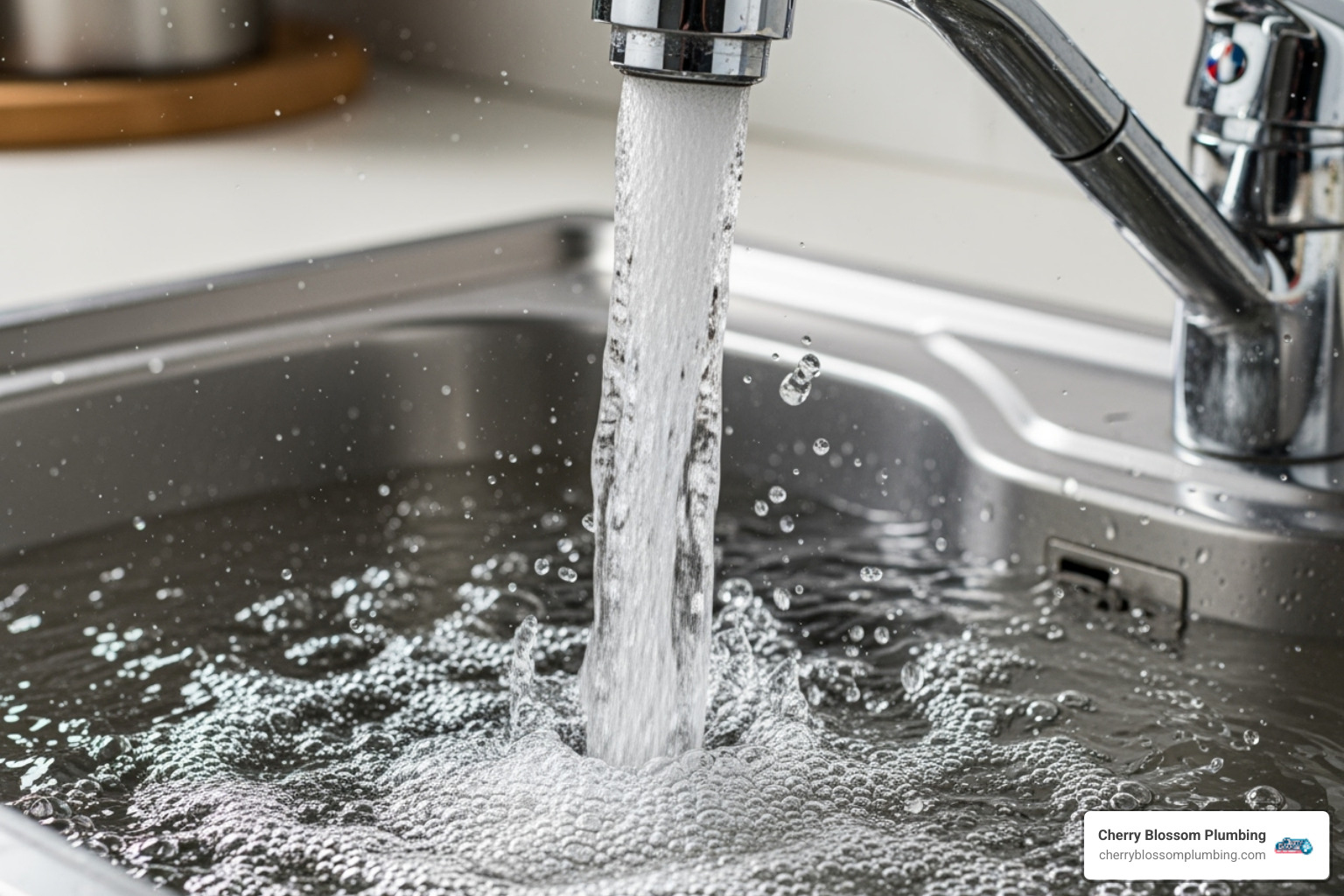
The bottom line? Your water utility can't fine-tune pressure for every individual home, which is why some houses naturally receive more pressure than their plumbing systems really want to handle.
The Damaging Effects of Excessive Water Pressure
Think of high water pressure as your plumbing system's worst enemy - it's relentless, working 24/7 to slowly break down everything in its path. While you might not notice the damage happening behind your walls, excessive pressure is quietly wreaking havoc on your home's most expensive systems.
Your pipes weren't designed to handle constant pipe strain from excessive pressure. Just like a balloon that's been inflated too much, your pipes are under continuous stress. The force pushes against pipe walls, joints, and connections with unrelenting pressure. Over time, this constant assault erodes the inside of your pipes, especially at vulnerable spots like bends and connections where the water has to change direction.
Pinhole leaks are one of the sneakiest problems caused by high water pressure. These tiny holes develop gradually as the rushing water wears away at your copper pipes from the inside. You might not even know they exist until you find water damage behind a wall or under your flooring. By then, what started as a microscopic leak has often caused thousands of dollars in damage.
Can high water pressure burst a pipe? Unfortunately, yes. While your pipes can handle normal pressure just fine, years of excessive force weakens them at their most vulnerable points - old joints, corroded sections, or previous repair spots. When a pipe finally gives way, it doesn't just drip - it can flood your home in minutes. I've seen this happen to families throughout Northern Virginia, turning a regular Tuesday into a plumbing nightmare.
Your appliances are taking a beating too, even if they seem to be working fine. Water heaters suffer tremendously under high water pressure. The tank and all its internal components are constantly fighting against excessive force. The temperature and pressure relief valve - your water heater's safety mechanism - gets triggered more often than it should, or worse, fails completely. This constant stress shortens your water heater's life significantly and can lead to expensive leaks or complete failure.
Washing machines and dishwashers aren't built for the punishment that high water pressure delivers. Water rushes into these appliances with too much force, overwhelming their delicate valves, seals, and internal pumps. The result? These expensive appliances wear out much faster than they should, leaving you with costly repairs or premature replacements.
Here's something many homeowners don't realize: voided appliance warranties can be a costly surprise. Some manufacturers actually specify acceptable water pressure ranges in their warranty terms. If your appliance fails because of damage from high water pressure, and you haven't installed a pressure regulator, you might find yourself completely responsible for repair or replacement costs.
Your wallet takes another hit through increased water bills. Those pinhole leaks and constantly dripping faucets waste more water than you'd expect. Plus, high water pressure means water flows faster from every fixture - you're literally using more water every time you wash dishes or take a shower. If your toilet keeps running because the fill valve can't handle the pressure, that's even more money going down the drain every month.
The bottom line? High water pressure isn't just a minor inconvenience - it's a serious threat to your home's plumbing system and your finances. If you're experiencing any of these warning signs, it's time to take action before small problems become major disasters. Our comprehensive plumbing services can help you assess your entire system and protect your home from pressure-related damage.
How to Manage High Water Pressure in Your Home
The great news about high water pressure is that it's completely manageable once you understand what you're dealing with. You don't need to live with banging pipes or worry about expensive damage to your appliances. With the right approach, you can protect your plumbing system and enjoy comfortable water pressure throughout your home.
Think of managing high water pressure like tuning a musical instrument - you need to first know what note you're currently playing, then make the right adjustments to get it in tune. Let's walk through this process step by step.
Testing Your Home's Water Pressure
Before you can fix a problem, you need to confirm you actually have one. Testing your water pressure is surprisingly simple and gives you the concrete information you need to move forward confidently.
Your first step is picking up a water pressure gauge from any home improvement store. These handy little devices cost less than twenty dollars and thread right onto your outdoor hose spigot. It's one of those tools that pays for itself the first time you use it.
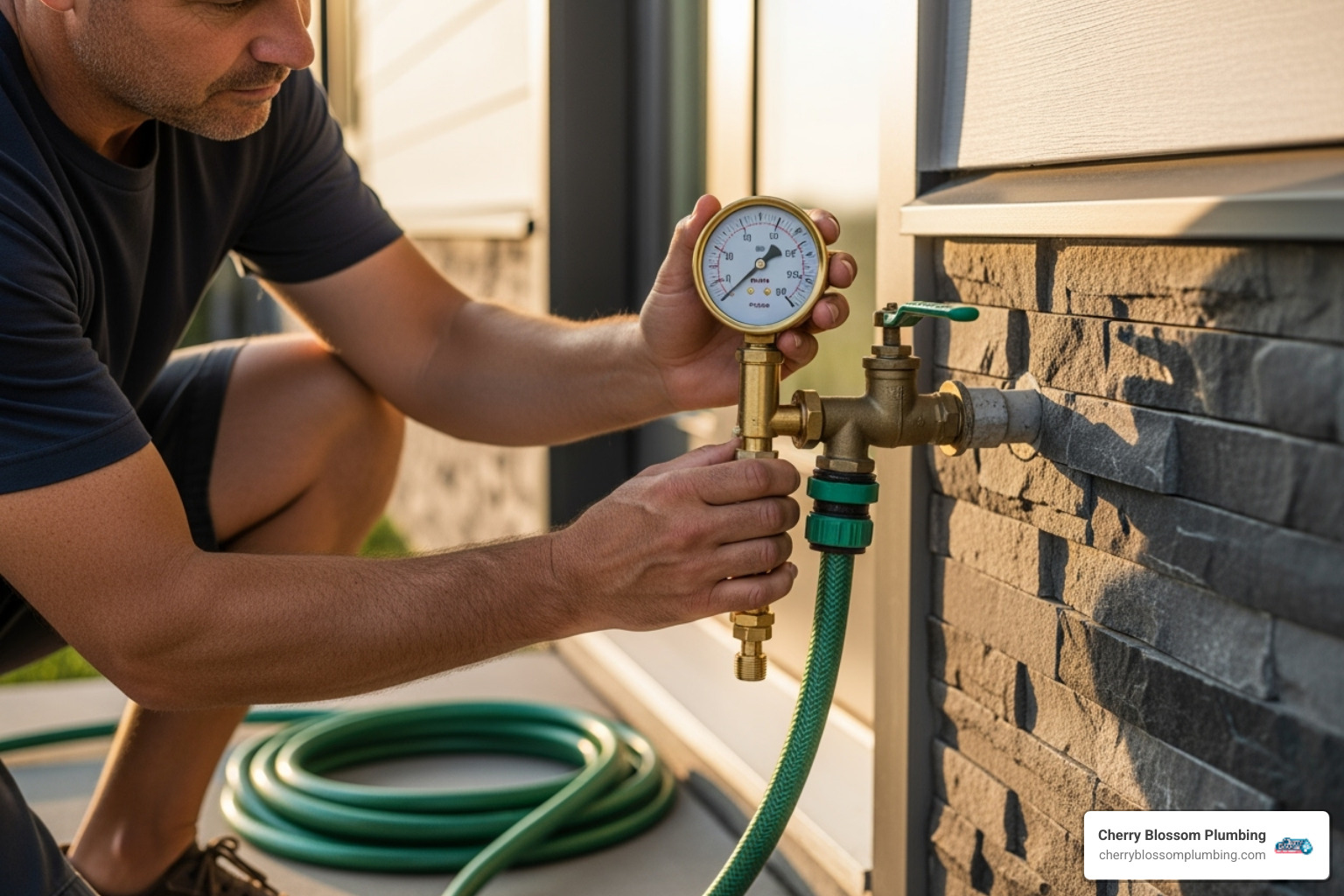
The key to getting an accurate reading is testing when no other water is running anywhere in your house. That means turning off washing machines, dishwashers, and even checking that toilets aren't refilling. You want to measure what's called static pressure - the pressure when water isn't actively flowing.
Choose either an outdoor hose bib or your laundry sink for testing. Thread the gauge on snugly to prevent leaks, then slowly turn the water on fully. The needle will jump to show your home's water pressure in PSI.
If your reading consistently shows above 80 PSI, you definitely have high water pressure that needs attention. Even readings above 70 PSI are worth addressing, especially if you notice any of those warning signs we talked about earlier.
Your First Line of Defense: The Water Pressure Regulator (PRV)
Here's where things get interesting. Many homeowners don't even know they have a water pressure regulator, but this small device is often the hero that stands between your plumbing and potential disaster.
A PRV looks like a bell-shaped valve, and you'll typically find it near your main water shutoff valve. It might be tucked away in your basement, garage, or crawl space - basically wherever your main water line enters your home.
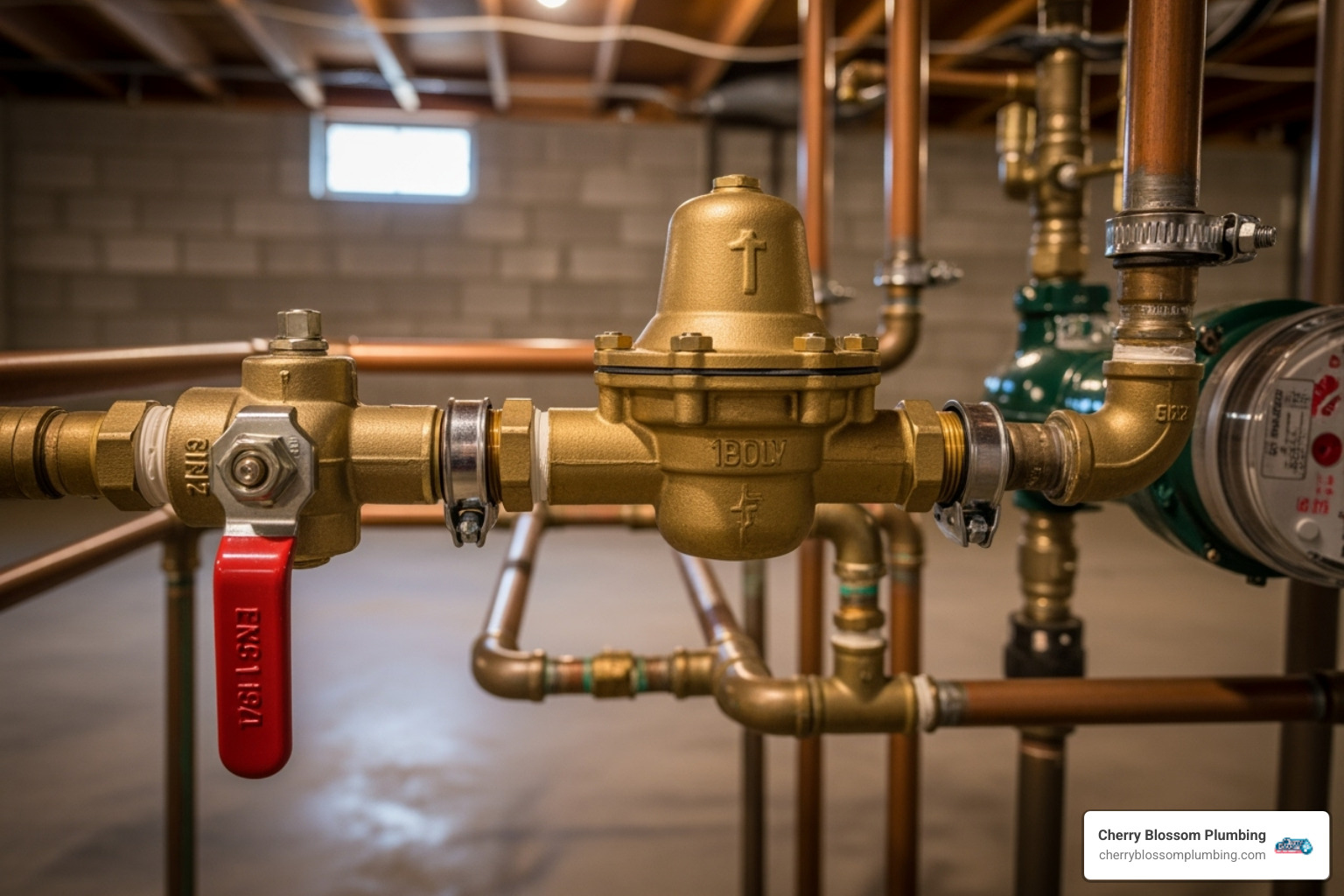
Think of your PRV as a bouncer at a nightclub. It lets water from the municipal supply enter your home, but only at the pressure level that's safe for your plumbing system. Inside, there's a spring-loaded mechanism that automatically adjusts based on incoming pressure. When the municipal pressure is too high, the PRV reduces it to a safer level - usually around 45 PSI from the factory.
Like any hardworking piece of equipment, PRVs don't last forever. Most have a lifespan between 7 and 12 years. After that, the internal components start wearing out, and the device may stop regulating pressure effectively.
If you're curious about your home's plumbing setup or want a professional assessment, our team can help you understand exactly what you're working with. You can learn more through our guide to our plumber services.
Adjusting or Replacing a PRV
Sometimes your PRV just needs a little adjustment to get your high water pressure back in the sweet spot. If you're comfortable with basic DIY projects, this might be something you can handle yourself.
Start by turning off your main water supply - safety first! Look for the adjustment screw on your PRV, which usually has a lock nut holding it in place. Loosen that lock nut just enough so the screw can turn.
Here's the part that feels a bit like magic: turning the screw clockwise increases pressure, while counterclockwise decreases it. Make small adjustments - we're talking quarter-turns here. After each adjustment, turn your water back on, run a cold faucet briefly to clear any air from the lines, then test your pressure again with your gauge.
Keep adjusting and testing until you hit that ideal range of 40-60 PSI. Once you're happy with the pressure, don't forget to tighten that lock nut back down to secure your adjustment.
But sometimes adjustment isn't enough. Your PRV might be telling you it's ready for retirement through several warning signs. Sudden pressure drops or unexpectedly high readings often mean the PRV is stuck and no longer regulating properly. Inconsistent pressure throughout the day - where water comes out strong then weak - is another red flag. Some failing PRVs even make whistling or humming noises, like they're trying to tell you something's wrong.
If your PRV is showing its age (beyond that 7-12 year mark) or displaying signs of failure that adjustment can't fix, it's time for a replacement. This job involves working with your main water line and often requires specialized tools and knowledge of plumbing connections. While the concept is straightforward, the execution can be tricky - it's typically a job where calling in professionals saves you time, stress, and potential complications down the road.
When to Call a Plumber for High Water Pressure Issues
While testing your water pressure and making simple PRV adjustments can be great starting points, there are definitely times when it's smarter to bring in the professionals. Think of it this way - you wouldn't try to perform surgery on yourself, and some plumbing issues deserve that same level of expert care.
Your PRV is showing its age or clearly failing. If your water pressure regulator has been faithfully serving your home for 7-12 years, it's earned its retirement. Even if it seems to be working, an aging PRV is like a ticking time bomb - it's better to replace it proactively than to deal with a plumbing emergency at 2 AM. When you're seeing obvious signs of failure like sudden pressure spikes, constant low pressure, or that annoying whistling sound, it's definitely time to call us.
You've tried adjusting your PRV, but your gauge still stubbornly reads above 80 PSI. Sometimes, no matter how carefully you turn that adjustment screw, the pressure just won't budge. This usually means there's something more complex going on - maybe the internal components are worn out, or there's an issue with your main water line that requires professional diagnosis. Don't keep wrestling with it; we have the tools and experience to figure out what's really happening.
Your home doesn't have a PRV at all. Many older homes in Arlington and Falls Church were built before PRVs became standard practice. If your pressure test confirms high water pressure and you can't find that distinctive bell-shaped device anywhere near your main water line, you'll need one installed. This involves cutting into your main water supply line - definitely not a weekend DIY project unless you enjoy unexpected indoor water features!
You're seeing signs of damage that could be pressure-related. Persistent leaks, mysterious water stains on walls or ceilings, or appliances that are failing earlier than expected can all point to high water pressure problems. These situations need immediate attention because the damage can escalate quickly and expensively.
You want peace of mind with a professional diagnosis. Sometimes the symptoms of high water pressure can overlap with other plumbing issues. What looks like a pressure problem might actually be something else entirely, or there could be multiple issues working together. Our team has seen it all, and we can give you a complete picture of what's happening with your plumbing system.
At Cherry Blossom Plumbing, we understand that plumbing problems never happen at convenient times. That's why we're committed to providing fast, reliable service to homeowners throughout Northern Virginia. Don't let high water pressure turn into a plumbing disaster - contact us for professional Plumbing Services and protect your home's most important systems.
Frequently Asked Questions about Home Water Pressure
Over the years, I've heard just about every water pressure question you can imagine from homeowners throughout Northern Virginia. Whether it's a concerned call at 8 PM or a casual conversation during a routine service visit, these are the questions that come up again and again. Let me share the answers that will help you understand what's happening in your home's plumbing system.
What is the ideal water pressure for a home?
The sweet spot for your home's water pressure is between 40 and 60 PSI. This range keeps your plumbing system happy while still giving you that satisfying shower experience we all want after a long day.
Think of it like Goldilocks and the three bears - not too high, not too low, but just right. While many building codes allow up to 80 PSI, staying in that 40-60 range is like giving your pipes, fixtures, and appliances a comfortable working environment instead of a stressful one.
When your pressure stays in this ideal range, your dishwasher won't sound like it's trying to break free from its moorings, your faucets won't spray water all over your bathroom counter, and most importantly, your expensive appliances will last as long as they're supposed to.
Can high water pressure cause my water heater to fail?
Absolutely, and this is one of those expensive lessons you definitely don't want to learn the hard way. High water pressure is like asking your water heater to work out at the gym 24/7 - eventually, something's going to give.
The constant force puts tremendous strain on your water heater's tank, wearing down the welds and accelerating corrosion from the inside out. But here's what really gets expensive: that little valve on the side of your water heater called the temperature and pressure relief valve (we call it the T&P valve) starts working overtime.
This safety valve is designed to release pressure when things get too intense, but under constant high water pressure, it starts activating way more than it should. Pretty soon, you'll notice it dripping, then flowing, then potentially failing completely. When that happens, you're looking at water damage on top of a water heater replacement.
I've seen too many Northern Virginia homeowners deal with flooded basements because high water pressure turned their water heater's safety feature into a liability.
Does my home's location in Northern Virginia affect its water pressure?
You bet it does, and it's actually pretty fascinating when you think about how water travels through our communities. High water pressure isn't randomly distributed - there's real science behind why some homes get hit harder than others.
If your home sits at the bottom of a hill in areas like Arlington or Falls Church, you're essentially at the receiving end of gravity's push. Water stored in those big municipal towers and tanks up high gains momentum as it travels downhill, arriving at your front door with extra force.
I've worked on homes where neighbors just a few streets apart - but at different elevations - have completely different pressure readings. The house at the bottom of the hill might be dealing with high water pressure at 90 PSI, while the house halfway up the same hill sits comfortably at 55 PSI.
Your proximity to municipal water mains and fire hydrants also plays a role. The water utility has to ensure fire hydrants have enough pressure for emergency services, which sometimes means nearby homes get more pressure than their plumbing systems really want to handle.
It's one of those quirks of living in an area with varied terrain like ours - beautiful rolling hills that make for great neighborhoods, but can create some interesting plumbing challenges along the way.
Conclusion: Protect Your Home's Plumbing System
High water pressure might seem like a luxury when you're enjoying that powerful shower, but as we've finded together, it's actually a silent threat lurking in your pipes. The hidden costs add up quickly - from those annoying dripping faucets that won't quit, to major appliances failing years before they should, to the nightmare scenario of a burst pipe flooding your home.
The good news? You're now armed with the knowledge to fight back. Regular pressure checks with a simple $20 gauge can save you thousands in repairs. It's like giving your plumbing system a quick health checkup - and who doesn't want peace of mind?
Remember those key warning signs we talked about: banging pipes, constantly running toilets, noisy appliances, and splashing faucets. Your home is trying to tell you something important. Listen to it! And if your pressure gauge shows readings consistently above 80 PSI, don't wait - that's your cue to take action.
Proactive maintenance is always cheaper than emergency repairs. Whether it's adjusting your existing pressure regulator or having a new one installed, addressing high water pressure now protects your wallet, your appliances, and your sanity later.
At Cherry Blossom Plumbing, we've seen too many Arlington and Falls Church homeowners find pressure problems the hard way - through flooded basements and failed water heaters. That's why we're passionate about helping families protect their homes before disaster strikes. Our team brings that family-owned care and "WOW factor" guarantee to every job, big or small.
Don't let high water pressure win this battle. Your home deserves better, and so do you.
Contact us for professional plumbing services today to schedule an inspection or get expert help with any water pressure concerns. We're here to keep your plumbing system running smoothly for years to come.
Customer Testimonials
Cherry Blossom Plumbing has consistently provided top-notch service, ensuring every issue is resolved efficiently and professionally.





